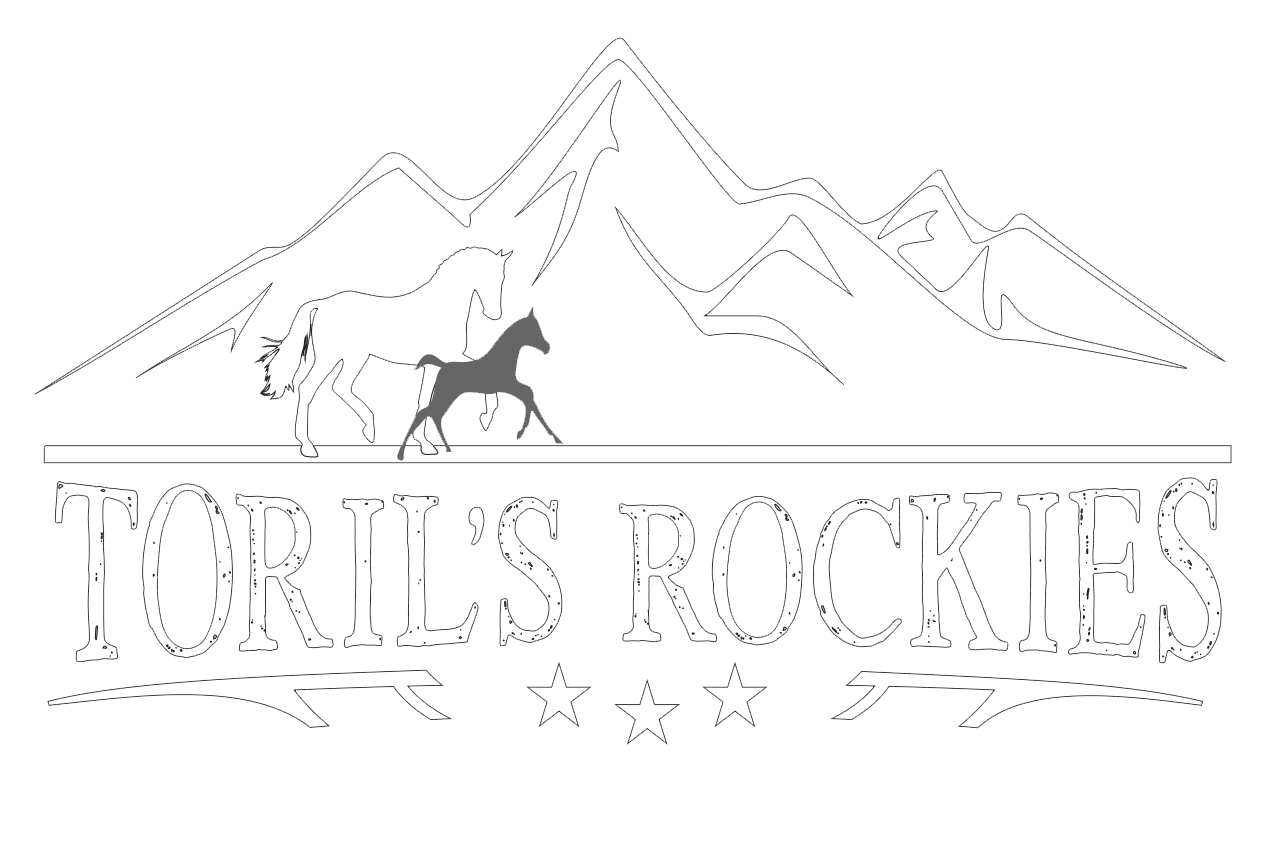The Rocky Mountain Horse
RasinformatieRocky Mountain Horses, gaited horses with a western background
Here is a little more information about the Rocky Mountain Horse as a breed, including its history, the studbook and special bloodlines. There is an explanation of the extra gait and a description of the breeding standard, plus the versatility of the Rocky Mountain Horse and some information about (colour) genetics and ASD. For more information I refer to the book Rocky Mountain Horses by Bonnie Hodge.
History of the Mountain Horses
In the rough Appalachian mountains of South Eastern USA a medium-sized horse of gentle temperament with an easy ambling four-beat gait was found. This gait made it the horse of choice on the farms and the rugged foothills of the Appalachians. It was a horse for all seasons: it could pull the plough in the small fields, work cattle, be ridden bareback by four children to the fishing hole, or to town comfortably on Saturday. They even performed well hitched to the buggy Sunday morning to go to church. Because of its cold-blooded nature, these horses tolerated the winters in Kentucky with a minimum of shelter.
The Rocky Mountain Horse
The Rocky Mountain Horse registry is based on bloodlines from foundation stock. Around 1940 a man called Sam Tuttle had a stallion on his farm that was called “Old Tobe”, a crossing between Mountain and western horses. This calm silver dappled horse was known for being a good trail horse that even brought young children through the rough mountains. The breeding standard of the RMH is totally based on the characteristics of this special stallion. The horse demonstrated a smooth natural four-beat gait, was gentle and people-friendly. Naturally, out-crossing with local horses did occur but the basic characteristics of a strong genetic line continued. This was the beginning of the Rocky Mountain Horse.
Bloodlines
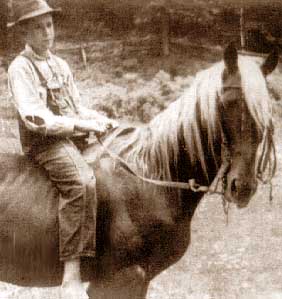
Because the Rocky Mountain Horse is a very young breed, the bloodlines are very interesting. You can see the history of the breed in the pedigrees of most individual horses. Almost every breed has so called Foundation stallions. These stallions have special characteristics which a breed is based on. With the RMH these stallions are the five sons of Tobe, mentioned above. To preserve the characteristics of a breed, offspring have to be crossed again. Naturally there needs to be genetic diversity, but at this stage in the development of the breed a high percentage of Tobe is desirable: the higher the percentage of Tobe, the more typical Rocky a horse is.
Again, Tobe was a stallion with many special features. Tobe was a very easy, confident riding horse who was very sure footed in rough terrain, friendly to everyone, strong and healthy as an ox, with a smooth natural four-beat gait (‘singlefoot’ – ie one foot striking the ground at a time). And as a special treat, he bore the beautiful chocolate coloured coat with flax mane and tail. Our horses are selected for their bloodlines. They have a high percentage of Tobe and are therefore typical of the breed, producing friendly and easy-going horses, with a comfortable gait; they are well built horses with the beauty a Rocky should have.
The 5 sons of Tobe
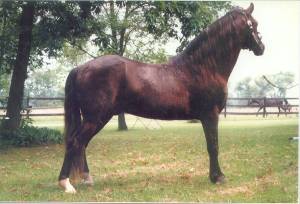
Kilburn’s Chocolate Sundown is known as the “Big Daddy” of the breed. Siring more than 600 offspring, he saved the breed from extinction. This horse had a perfect four beat gait and was very friendly, as well as tough and beautiful to look at. He gave his perfect gait, which Sam Tuttle always sought, to his offspring. He is the sire of famous stallions such as Nuncio, Choco, Jonhson’s Toby and Dan’s Dusty action.
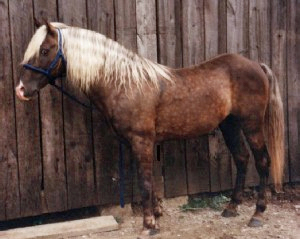
Sewell’s Sam was known for his looks – he was a big dark chocolate horse with a long white mane and tail, who made a big impression on people. He was very stockily built with a gentle personality. His offspring are known for their disposition – friendly and easy. He is the sire of Broken Bones Sam’son, Buddy Roe, Sam I am, Toco Sam. The cross between Kilburn’s Chocolate Sundown and Sewell’s Sam bloodlines is called “the golden Cross”.
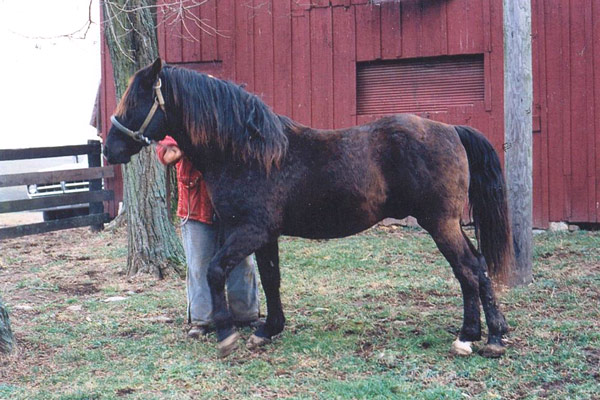
Maple’s Squirrel was known for his smooth four-beat gait and prowess on the trail: “he could climb a mountain like a squirrel goin’ up a tree”. He also had a wonderful disposition and was completely “child proof”; he took riders small and big safely through the mountains. A famous picture of this stallion shows him with five children riding him bare back at the same. He could adjust perfectly to the person on his back and understood you have to be careful with children. Squirrel was a black stallion, very soundly built; he was the sire of Squirrel Too and other comfortable gaiting horses.
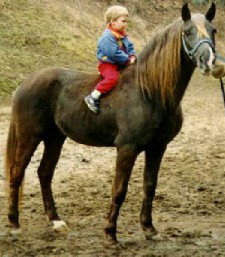
Sam Clemon’s Tim was a big horse with dark chocolate colouring and white mane and tail, who despite never being shown, became famous as a good breeding stallion by word of mouth. He also had a lot of offspring with easy-going personalities, good gaits and especially nice-looking heads. He was the sire of Nick, Blue Rain, Jubal T, Jim’s Jaywalker, and Diana’s Blue Star.
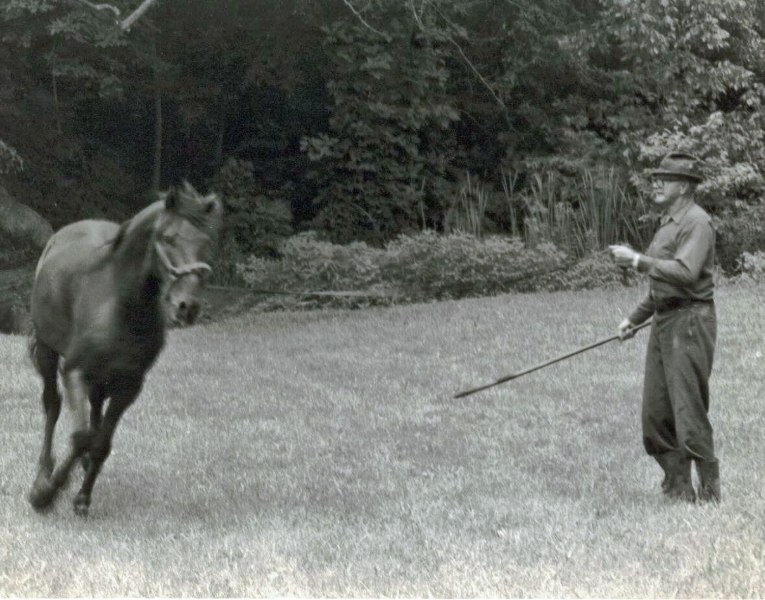
Yankee, at 15.2 hands, was the last and biggest son of Tobe. A brown horse, he was used by Sam Tuttle to breed from after Tobe died. He gave height to his foals as well as the friendly disposition and smooth gait the breed is loved for. His last owner made the well known comment: “Most owners can’t have just one Rocky”, when, during a photoshoot, a cat was observed to be sleeping on Yankee’s back. Yankee is the sire of Yankee Clipper and lots of others. All the five sons of Tobe were very healthy and lived to be more than thirty years old.
Endangered
To get the Rockies off the endangered breed list, Rocky lovers went looking for mares that fitted the breeding standard and which could be bred to certified stallions to produce more Rockies. These mares were called ‘grade’ mares. A daughter of such a mare, after certification, can get full Rocky Mountain Horse papers, but a son has to be gelded to get RMH papers. If there are a lot of grade mares in the bloodlines of a horse, there is a chance that the horse is a less typical Rocky. You should be able to get an idea by looking to see what’s “behind” such a grade mare; if there is a Paso Fino or Tennessee Walker, say, this tends to yield a different type. So by studying the papers of a RMH you can tell something about the history and qualities of a horse.
Breed standard and rules
To breed a Rocky both dam and sire have to be certified. The characteristics established for the breed are:
- The horse must be of medium height from 14.2 to 16.0 hands, with a wide chest sloping 45 degrees on the shoulder with bold eyes and well-shaped ears.
- The horse must have a natural ambling four-beat gait (singlefoot or rack) with no evidence of pacing. When the horse moves you can count four distinct hoofbeats which produce a cadence of equal rhythm, just like a walk: left hind, left fore, right hind, right fore. Each individual horse has its own speed and natural way of going, travelling 7-20 miles per hour. This is a naturally occurring gait present from birth that does not require any training aids or action devices (i.e., chains, soring, or built-up shoes).
- It must be of good temperament and easy to manage
- All Rocky Mountain Horses have a solid body colour. Facial markings are acceptable if they are not excessive. There may not be any white above the knee or hock.
The extra gaits of the Rocky
The most special feature of the RMH is the extra gait. In addition to walk, trot, canter and gallop they have a four-beat gait. The best known four-beat gait in Europe is the ‘tölt’ of Icelandic horses. This is a rythmicle four beat gait, also the most ideal for a Rocky Mountain Horse. If you listen to the feet hitting the ground it is always an even “takke-takke-takke-takke” rhythm. With Rockies it is called the singlefoot (or a rack). If the horse performs this gait the rider sits still in the saddle even when the horse is going as fast as a trot, which is very comfortable! In the southeast USA (as in Latin America) there are many types of easy gaited horses, all with subtle variations in their way of going. However, the mountain horses are reputed to be the smoothest of them all to ride – the famous ‘glide ride’. The gaited horses, as they are known, are descended from the horses of medieval Europe, particularly Britain (where they were known as ‘palfreys’) and Spain; they were brought by ship to the New World by the colonists. For people with back pain and other physical problems, or older people or beginners, the easy gait is great to ride; it is also wonderful if you just want to have a comfortable ride. If you want to ride long distance, for example trail or endurance riding, you can ride trot, singlefoot etc… the variation is good for horse and rider. There are other breeds with extra gaits, but the Rocky MH is also a very confident and reliable riding horse. You can ride a comfortable gaiting horse from another breed, but when it spooks a lot, that is not good for your back……..
The versatile Rocky
In the US the Rocky is still a rare breed, but it is growing very fast because of the popularity that the breed has gained, being a comfortable riding horse with its calm disposition and four-beat gait, suitable for recreational riding, even for older people or people with disabilities. Some say it is a ‘wonder horse’: people who thought they weren’t able to ride any more find that is not so when they try out a Rocky Mountain Horse. The Rocky is an ‘easy keeper’ and a wonderful riding horse with a strong heart and stamina. Today the Rocky Mountain Horse is being used as a pleasure horse, both for trail and competitive or endurance riding. As show horses, the breed is rapidly gaining in popularity because of its beauty and unique way of moving in the ring. These horses have a lot of natural endurance; they are sure-footed on rough ground and because of their gait, require a minimum of effort by both horse and rider, so that together they can cover a greater distance with less fatigue. Some Rockies are seen in western riding!
Chocolate with flaxen mane and tail
Rockies can have many varieties of solid coloring. The signature colour of the breed have the rare chocolate and flax mane and tail coloring. The body can be light to dark chocolate, often with dapples and the mane and tail can be dark flax to pure white. This beautiful colour is seen in some other breeds, such as Icelandic’s, Shetlands, Morgans, and Kentuckies, which are also said to be ‘cold-blooded’ horses.
Genetics
A horse has two basic colour genes: black (dominant over red, so Aa or AA) and red (aa). A bay horse is basically black but has an extra agouti gene which colours the black horse brown (with black points).
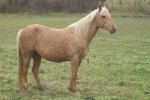
Palomino
If a horse has basic black (A) and a so-called silver dapple gene then the black is changed to chocolate with flax mane and tail. The silver dapple gene is a colour dilution gene as with the palomino horse:
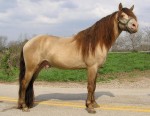
Champagne
palomino is a red horse (aa) with a cream dilution gene. There are four kinds of colour dilution genes in horses: “champagne”, “cream”, “dun” and “silver dapple”

Red Chocolate
A bay horse with the silver dapple colour dilution gene is known as “red chocolate” with flax mane and tail. If the horse is red, ie sorrel (aa), then the silver dapple gene does not appear; the horse is a carrier but the gene does not dilute the coat colour.
Chocolate with flaxen mane and tail
The RMH breed carries the genetic eye fault ASD (Anterior Segment Dysgenesis) which manifests in a small number of individuals This is a fault in the development in the eye of the horse, affecting the young horse, though it can improve with age. But there are other faults that can occur. It is something to be careful about as a breeder. The theory goes that the gene is close by the colour gene, so that only homozygote silver horses can be affected by ASD. Though latest research indicates that the silver gene is also found on a second allele, so it is not always so… Recently it became possible to do genetic testing of the silver dápple gene. So hopefully there soon will be more answers regarding the eye fault ASD and the colour chocolate with flax mane and tail. It is mistaken to believe that ASD is a big problem in the breed. When the RMHA found that this was affecting their breed, they initiated significant research – an achievement for such a small association. ASD is colour-related, so affects all breeds with this colour. It was found that ASD does indeed affect the RMH but on such a small scale it is not a real problem. Other genetic problems are not even mentioned if they occur on this scale in a breed – only 2.5% of the breed is affected by ASD. ASD only occurs with homozygote silver dápple horses, so ZZ. So a heterozygote Zz is free of problems! So make sure you buy a Zz chocolate horse!
